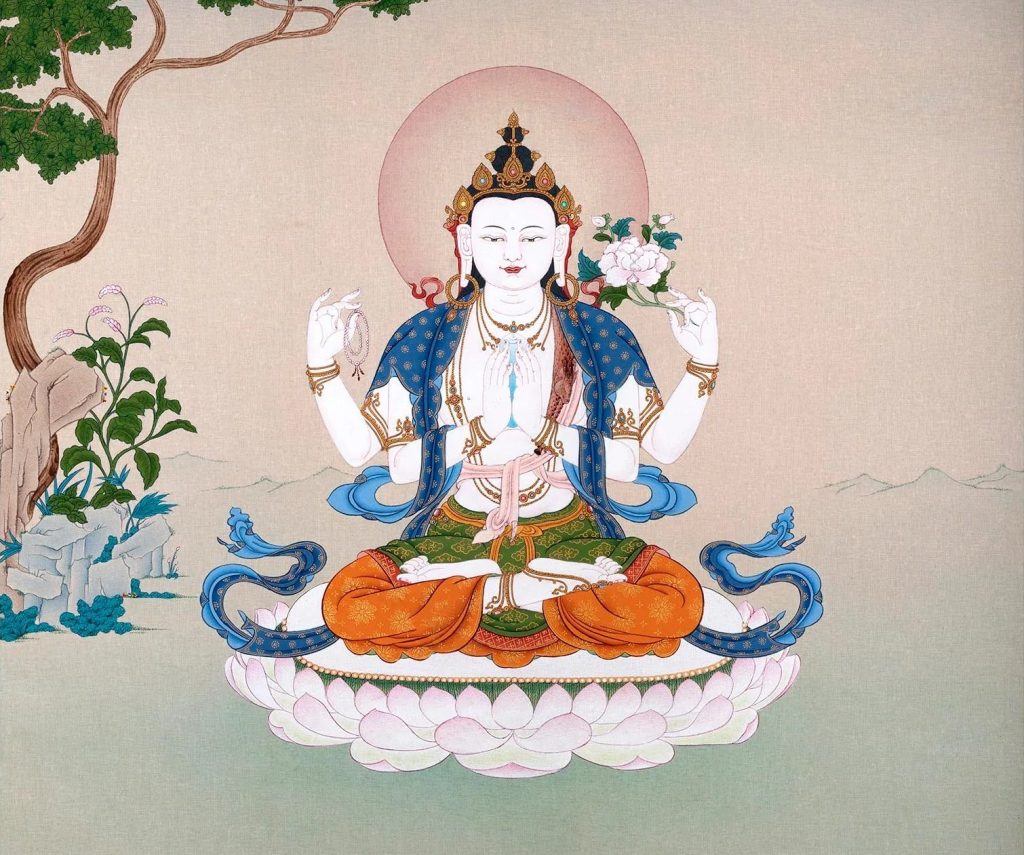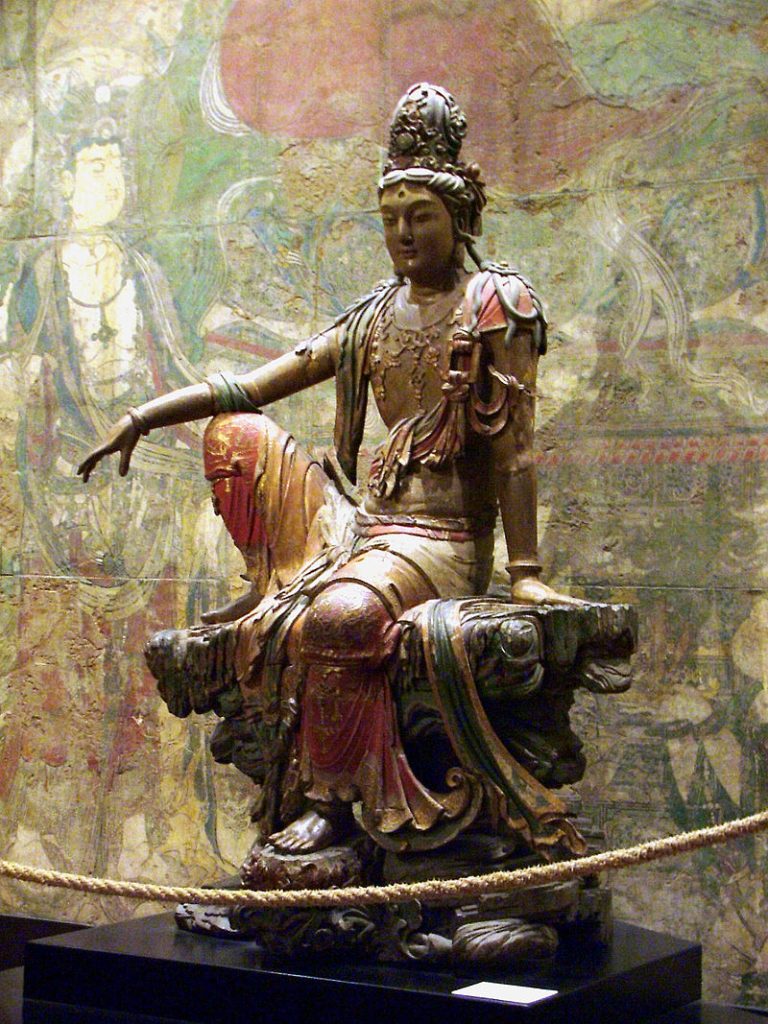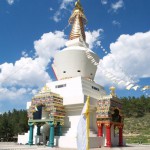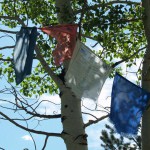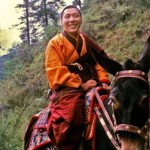Tuesday
Meeting Chenrezig in Sound: Understanding Chenrezig’s Name and the Meaning of the Chenrezig Mantra
by Frederick Meyer
An excerpt from the Shambhala Online Blog posted April 12, 2024
In recent years, Chenrezig—the Tibetan name for the Buddhist deity Avalokiteshvara, the Bodhisattva of compassion—has become an important part of my spiritual practice. I have a strong affinity for sound, and much of my learning about Chenrezig has been in the form of sound and meaning: what “Chenrezig” itself means and how it relates to Avalokiteshvara’s other names, what the Sanskrit and Tibetan versions of the word compassion actually mean, and the meaning of the famous Chenrezig mantra OM MANI PADME HUM.
In this article, I want to share both what I’ve learned about Chenrezig himself, as well as my own process of exploration. I feel the process I’ve followed shows how association and meaning can unfold along the Buddhist path, especially the parts of the path that are rich in energy and iconography.
Throughout this article, I’ll be describing what I learned about Chenrezig in my explorations , as well as weaving in Chögyam Trungpa Rinpoche’s teachings on the same topic. I only discovered Trungpa Rinpoche’s teachings on Chenrezig within the past month, so it’s been very interesting to compare my own independent learning with his teaching, and I hope to illustrate that dynamic as well.
Chenrezig: First Connections
I had heard of Chenrezig growing up, but I didn’t connect strongly to Chenrezig until around three years ago, when my father, a longtime Buddhist practitioner, began practicing Four-Armed Chenrezig sadhana practice with a Tibetan Lama living in Hawaii. At his suggestion, I began joining for the weekly sadhana practice.
The lama often played a YouTube video (with the sound off) during the visualization part of the sadhana. The video includes a thangka of Chenrezig that I really like—something about the eyes and facial expression, and the vibrant colors. I found that looking at it gave me a certain feeling, and I began to carry that with me.
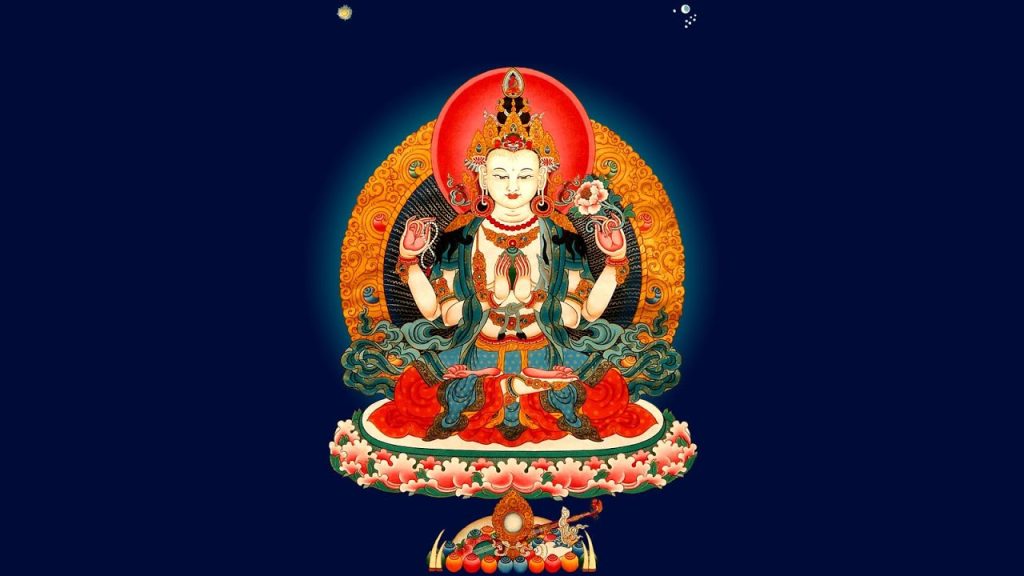
Because of his enthusiasm for the practice, I gifted my father a Chenrezig thangka for one of his birthdays, and then later bought one for myself. When my thangka arrived (about a year and a half ago now), I found that the energy of my own interest in and connection with Chenrezig heightened significantly.
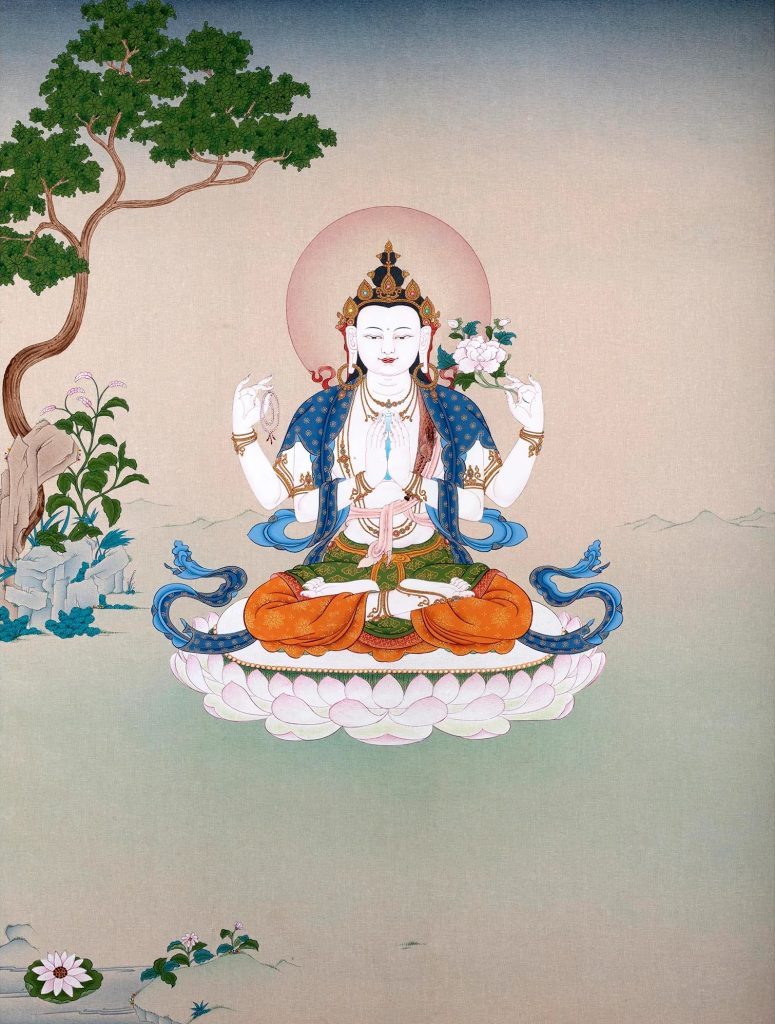
From there, I began exploring Chenrezig in earnest, and that’s where I began to learn in depth about Chenrezig’s name, the meaning of compassion, and the meaning of the Chenrezig mantra.
Chenrezig: What the Name Means
The Tibetan name Chenrezig means “continuously looking,” and has been translated as:
- “One who looks with unwavering eye”
- “Unblinking Eyes”
- “One who always looks upon all beings (with the eye of compassion)”
Trungpa Rinpoche translates Chenrezig as: “He Who Sees All Sentient Beings.”
Chenrezig is the Tibetan version of the Sanskrit name Avalokiteshvara, which means “lord who gazes upon the world.” The idea of this name (in both Sanskrit and Tibetan) is that the loving gaze of compassion—the gaze of Chenrezig, compassion itself—forever holds all beings.
Avalokitasvara: The Female Compassion Deity
What I find most interesting about Chenrezig’s name is that there is another form of the Sanskrit name Avalokiteshvara. Wikipedia does a wonderful job summarizing the history, and it felt like a major revelation to me when I read it. The other name is Avalokitasvara: “Who hears the cries of the world.”
Western scholars originally thought this name had been made up, in error, by Chinese translators from Sanskrit, who named the deity Guanshiyin, “[The One Who] Perceives the Sounds of the World,” or “who perceives the world’s lamentations.” Shortened to Guanyin (and later rendered in Japan as Konan), this is the contemporary Chinese name for Avalokiteshvara, who is represented as a female compassion deity.
Scholars later realized that Avalokitasvara is actually a correct—and older—name of the deity, which was later developed into Avalokiteshvara (adding the sense of “lord” and changing “hear” to “see”). Guanshiyin, “Who Hears the Cries of the World,” wasn’t a mistranslation at all.
As I mentioned, I have a strong affinity for sound, and learning this alternate name of Chenrezig had a profound effect on me. One who gazes (lovingly) upon the world sounds, to me, nice but a little distant—but “hearing the world’s cries” carries a strong feeling I can immediately connect with.
In fact, many of my most immediate and piercing experiences of compassion have been sound-based. As an example, I have a small dog, and this morning when I picked her up, she yelped loudly (I don’t know why, and she wasn’t hurt). I was immediately pierced by a feeling that was so immediate I didn’t have a name for it. I feel it was a strong hit of compassion—the powerful, immediate, primordial feeling that is true compassion, not the refined notion of charity and concern for others that we might often think of.
To continue reading Meeting Chenrezig in Sound: Understanding Chenrezig’s Name and the Meaning of the Chenrezig Mantra by Frederick Meyer please visit the Shambhala Online Blog webpage here.
Entries filed under Community Articles
Mukpo House – HIGHLIGHT
by Judith Broadus The Mukpo House in Lexington, KY arose from the Shambhala vision of merging spirituality with our everyday lives to create enlightened society. As it states on the website of Sakyong Mipham Rinpoche, the spiritual head of Shambhala Buddhism, “The Shambhala tradition believes in the ... continuePosted August 15, 2011 by
Please, Hold Your Applause – HIGHLIGHT
New: Shambhala Culture Column! by Sangyum Wendy Friedman The Shambhala Times is pleased to present a new column on the topic of Shambhala Culture and Decorum. Hosted by Sangyum Wendy Friedman, the Director of the Office of Culture and Decorum, the purpose of this column is to pose ... continuePosted August 5, 2011 by
Transforming Society – Not Spreading “Dharma-lade” – HIGHLIGHT
by Travis May Over 150 seminarians, staff, and local guests squeezed into the the main shrine hall at Karme Choling this month as the Kongma Sakyong, Jamgon Mipham Rinpoche, gave profound and practical teachings to the assembly gathered for the first ever Vajrayana Seminary at Karme Choling. ... continuePosted August 1, 2011 by Travis_May
Mythology and Everyday Life
I’ve been wondering lately what Joseph Campbell would think of Shambhala Buddhism. He attributed many of the problems we face today, particularly our disconnect from nature and the resultant chaos & confusion found in our global society, to a lack of a working mythology. ... continuePosted July 28, 2011 by Travis_May
A City Encampment: Can we really do this? – HIGHLIGHT
by Lulu Strongheart, Rusung at the San Francisco Shambhala Center During Memorial Day weekend, the Northern California Lhasang Regiment of Dorje Kasung hosted a program at Sharchen Dzong, the San Francisco Shambhala Center, that was entitled: “Dorje Kasung Leadership Training and Celebration of Kasungship.” It was a ... continuePosted July 26, 2011 by
Stupa Tears: Transforming Our World – HIGHLIGHT
[caption id=”attachment_25361″ align=”alignright” width=”242″ The inexhaustible generosity of the Sakyong was evident as the afternoon wore on and the hot sun beat down. For those that have never been there, the Great Stupa is indeed great. It is a symbol of peace and a monument to ... continuePosted July 17, 2011 by Sarah
On Being Brave – HIGHLIGHT
With over three hundred people in the large shrine tent at Shambhala Mountain Center at the beginning of July, there was a lot of heat. Heat of the mountain sun, heat of expectation and desire, heat of insight and the heat of longing. This heat was ... continuePosted July 15, 2011 by Sarah
At The Heart – HIGHLIGHT
By Ron Schultz member and practitioner at the Los Angeles, CA sangha Finding the words that convey the opening of one’s heart and the transformation of one’s existence seems like a better task for a Gershwin or a Porter than a Schultz. But nonetheless, it is mine. I ... continuePosted July 11, 2011 by ron_schultz
Befriending Our Habits and Ourselves – HIGHLIGHT
By Lisa Montanarelli The week before Shambhala Day, the Atlanta Center offered “The Shape of Awake,” a weekthun with Hope Martin. Based in New York City, Hope has taught the Alexander technique for 25 years. She brilliantly combines this technique with meditation instruction to help meditators let ... continuePosted July 9, 2011 by Lisa_Montanarelli
Owning the Bow – HIGHLIGHT
By Patrick Groneman My girlfriend and I sit down for breakfast in our narrow Brooklyn kitchen. The sun strolls through sheer white fabric and onto the pale wooden countertop next to us. I’m holding a black ceramic bowl of oatmeal at eye level out in front ... continuePosted July 5, 2011 by
The Man With Many Faces: Remarks on the Film Crazy Wisdom – HIGHLIGHT
By Heather Grimes Not giving up on anything seemed to be the basic point. Willing to work with what is there on the basis of a primordial wakeful quality seems to be the definition of Crazy Wisdom. – Chogyam Trungpa Rinpoche. Photos of Chogyam Trungpa ... continuePosted July 3, 2011 by
A New Journey Begins – HIGHLIGHT
Sarah Lipton is stepping in as the new Content Manager of Shambhala Times. She recently finished a four year tenure as the Center Coordinator at the Boston Shambhala Center where she developed and managed the Wake up Boston! blog. Good morning, Shambhala! I am writing to ... continuePosted July 1, 2011 by Sarah
A Yak’s Tale of Liberation – HIGHLIGHT
Liberating the life of animals, called tsethar in Tibetan (tshe thar), is a longstanding practice in Tibetan areas. In its traditional form, the practice involves offering a nomadic family a sum of money to keep a yak for the duration of its life. The yak is ... continuePosted June 30, 2011 by Holly
My Summer at Dechen Choling – HIGHLIGHT
Rianne Pelleboer, a young sangha member from Holland is spending her summer at Dechen Choling as a volunteer. The following is her account of her experiences living there. The Decision Discontentment. That word covers how I felt before going from A to Z. I had dropped my ... continuePosted June 15, 2011 by
Under 30 Retreat: Doing Something Profoundly Important – HIGHLIGHT
By: Meghan Misset The Boston Shambhala Center Under 30 Group was formed in 2003 and has a strong core of 20-30 young Sangha members. They recently embarked on a trip to the Shelburn Falls Center, in Western Massachusetts, where they sat in retreat for the weekend. Led ... continuePosted June 10, 2011 by
![]() RSS feed for the Community Articles category
RSS feed for the Community Articles category
View all posts from authors in Community Articles: Jillian_Johnson

